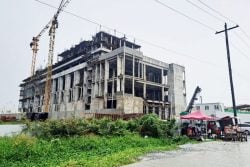Now retired, Ulric (Neville) Trotz was formerly the Deputy Director & Science Adviser, Caribbean Community Climate Change Centre, Belmopan, Belize.
Recently it was announced that the government had signed an agreement with a local firm, Professional Waste Solutions Incorporated (PWSI), to construct and operate a facility at Coverden on the East Bank of Demerara to process the wastes generated by the offshore Oil and Gas drilling exercises taking place in Guyana. According to the announcement, the project has been approved and cleared of any obligation to conduct an Environmental and Social Impact Assessment (ESIA), which normally is an essential requirement for such an activity. The waiving of this requirement is based on a previous decision of the Environmental Protection Agency in 2021 to grant permission for another entity, Global Oil Environmental Services (GOES), an American based firm, to proceed with the implementation of the proposed waste management facility. Waiving of the need for an ESIA in this case was apparently premised on the EPA’s assessment that their application had satisfied the necessary criteria with respect to the safety of the operation and that all of the environmental and social impact risks were adequately addressed in their proposal. Hence the need for a comprehensive ESIA by PWSI was waived.
An Oil and Gas management facility is required in Guyana to process and dispose of the wastes generated by the industry, mainly from its offshore drilling activities. It requires specialised knowledge, technology and skills to operate it safely and effectively, so as to ensure that it does not compromise the integrity of the surrounding environment where it is sited, the health and well-being of the community where it is located, or disrupts the livelihoods of the latter. The scale and nature of the proposed operation can be gauged from a recent release in the publication Oil Now on July 7th 2024, stating that:
“ExxonMobil Guyana Limited (EMGL) has issued a request for information (RFI) for Waste Management Services, focusing on waste oil, hazardous waste, and non-hazardous waste. EMGL aims to evaluate the services and capabilities of potential suppliers to manage these waste types from its operation in Guyana.
The chosen supplier will be responsible for providing onshore equipment, facilities, and personnel. They must also offer containers, tanks, vessels, or other storage solutions for temporary storage, transport, and treatment of waste oil.
Additionally, the supplier will provide hazardous waste trucking services. If not already available, EMGL may require the supplier to secure land within 20 miles of Houston, Greater Georgetown, or elsewhere on the East Bank of Demerara.
The search for suppliers capable of meeting these stringent specifications aligns with Exxon’s long-term objectives for the Guyanese energy market.”
To manage wastes from an offshore oil drilling operation at an onshore facility, especially in an environmentally sensitive area like Guyana, it is essential that several key environmental issues be managed comprehensively to minimize the facility’s impact on Guyana’s environment and ensure its sustainable operation. This is accomplished through the process of requesting the applicant for the construction and operation of such a facility to carry out a comprehensive Environmental and Social Impact Assessment (ESIA), which is geared to identifying the risks that the proposed activity poses to the integrity of the environment and to assess its likely impact on the communities in the vicinity of the facility, and to design the project in a manner that addresses these risks.
The United Nations Environment Programme (UNEP) defines Environmental and Social Impact Assessment (ESIAs) as a tool used to identify the environmental, social and economic impacts of a project prior to decision-making on its implementation. ESIAs aim to help the developer predict environmental impacts at an early stage in project planning and design, find ways and means to reduce adverse impacts, shape projects to suit the local environment and present the predictions and options to decision-makers.
The ultimate aim of the ESIA exercise is to ensure that an activity does not compromise the integrity of the local environment to the detriment or inconvenience of the community and is in full compliance with national laws and regulations designed for that purpose. In some cases, due to the findings of an ESIA, decisions are made to abandon the project altogether. By using ESIAs, both environmental, social and economic benefits can be achieved, such as reduced cost and time of project implementation and design, avoided treatment/clean-up costs and full consideration given to mitigating risks to the well-being and safety of the community.
When originally conceived, countries were asked to prepare Environmental Impact Assessments (EIAs) for any development projects that were being undertaken. This was supposed to address the mitigation of the impacts of the development on the environment. However, in recent years with the advent of the climate change problem, there was a paradigm shift and countries were required to include consideration of the likely impact of an environmental factor, in this case climate risk, on their intended development projects. Also, an increased awareness of the possible disruption of the lives and livelihoods of communities, because of development projects, led to the inclusion of the assessment of the social impacts of development projects, hence the present request for ESIAs.
It is in the interest of all concerned to carry out ESIAs on development proposals, particularly in Guyana, given our vulnerability to risks arising from climate change and existent threats to the integrity of our environment. This applies across the entire spectrum of our infrastructural development thrust – roads, bridges, onshore facilities for the oil and gas industry, housing, health and educational facilities, water, power utilities, agriculture – indeed in every facet of our life. Guided by the principle of resilience and sustainability, we must ensure that
climate risk assessment informs everything we do. And these are to be carried out through conducting comprehensive ESIAs as part of our due diligence, both to protect our pristine environment and to ensure the long term sustainability of our investments in development.
Let us return to our consideration of the proposed waste processing facility at Coverden . Some of the issues to be addressed include possible water and soil contamination caused by rainwater runoff from the facility, potentially contaminated with oil, chemicals, or other hazardous substances. Drill cuttings, contaminated soil, and other solid wastes need to be carefully managed to prevent soil contamination. Improper disposal or spills can introduce toxic substances, including heavy metals and hydrocarbons, into the soil. The storage of chemicals, fuels, and other hazardous materials should be designed to prevent leaks or spills that could contaminate the soil. Given Guyana’s quest for food security, it can ill afford to compromise the quality of its soil and water resources which are necessary for its ability to produce food suitable for human consumption. We face a similar challenge from the use of mercury in our artisanal gold industry in that it has polluted rivers and the fish which is consumed by some of our inland dwellers. Particular concern needs to be paid to the handling of radioactive wastes derived from the drilling process and to ensure that through improper handling these do not enter into the national food chain.
Transporting waste from offshore operations to the onshore facility involves the risk of spills, both at sea and on land, thus necessitating the implementation of robust spill prevention and response strategies. Note that this risk is not confined to the location of the processing facility, but is ever present along the entire route from the point of generation of the waste to the processing facility. In addition increased traffic from waste transport can affect local roads and infrastructure, potentially leading to environmental degradation or accidents. Likely impacts are not confined to the location of the facility!!
The processing of waste materials can release Volatile Organic Compounds (VOCs) into the atmosphere, contributing to air pollution and potential health risks for nearby communities. Handling and processing of solid waste materials can generate dust, which may carry hazardous substances and affect air quality. Waste to be processed includes drill cuttings which often contain oil-based fluids and other contaminants. Proper disposal methods, such as thermal treatment, or secure landfilling, are employed to prevent environmental contamination. Further, some wastes may be classified as hazardous under environmental regulations, requiring special handling, transportation, and disposal procedures.
Of paramount importance, the facility’s operations could affect nearby communities through environmental degradation, health risks, and changes to livelihoods, particularly if communities rely on fishing, agriculture, or ecotourism. ESIA’s stipulate that in the process of their compilation, continuous engagement with local communities, and other stakeholders is crucial to address concerns, ensure transparency, and build trust.
One of the major wastes generated by the offshore drilling is the produced water which is highly contaminated and requires careful management to minimize ecological impact. Global best practices for the disposal of produced water exist e.g. reinjection into a suitable underground reservoir, onsite treatment to remove harmful substances before discharge into the ocean environment.
I do not have the information on how this is being managed but we should all expect that it is being managed in situ. The plant is to be operated by local workers and it is expected that due attention would be paid to their safety as they carry out their duties. They should undergo comprehensive training on the handling of hazardous materials, equipment operation, and emergency procedures, and be provided with appropriate Personal Protective Equipment, such as respirators, gloves, safety glasses, and protective clothing. The facility should also be equipped with ventilation systems, leak detection, fire suppression systems, and other engineering controls to minimize risks. Management should also undertake routine inspection and maintenance of equipment to prevent malfunctions and hazardous releases and be fully prepared for accidents, including fire, chemical spills, or gas releases, with proper response protocols in place.
Construction and operation of an Oil to Gas waste management facility to process waste from Guyana’s offshore drilling operations, does indeed pose significant threats to the local environment and to communities where this facility will be located and beyond. It would certainly allay the fears of those at risk and wider Guyanese community, if they were involved in a transparent and inclusive process that would inform them of the details of the proposed facility, get their input into ensuring that their concerns were considered and addressed in its final design, and reassure the public that such a facility is in full compliance with Guyana’s laws and regulations. This is one of the major outcomes of carrying out comprehensive and professional ESIA exercises for projects related to our development and would go a long way in bridging the divide between the administration and the people whose lives are impacted by their decisions.




